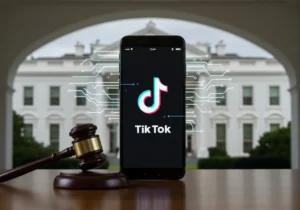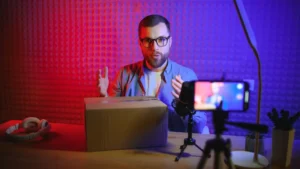In the past few decades, the world of media has undergone a radical transformation. With the rise of the internet, traditional methods of consuming content—such as print newspapers, radio, and television—have been replaced by dynamic, digital-first experiences. Online media has become the cornerstone of communication, entertainment, news, and education. But how exactly has the digital age shaped online content? What has driven the evolution, and where is it headed?
In this blog post, we’ll explore the journey of online media, its impact on content creation and consumption, and what we can expect from the future.
1. From Print to Digital: The Birth of Online Media
Before the rise of the internet, most people consumed content through traditional means—newspapers, television, and radio. However, as the internet began to take hold in the 1990s, media companies realized that the digital world was a space ripe for innovation.
The shift from print to digital began slowly, but as personal computers and smartphones became more common, consumers started to demand access to information at the click of a button. Websites like Yahoo!, AOL, and MSN began offering news, entertainment, and other content online, creating a shift away from traditional, static formats to a more interactive and real-time medium.
Mind-blowing fact: The first online news article was published in 1993 on the The San Jose Mercury News website. At the time, it was a novel concept for readers to consume news in real time, outside the traditional newspaper format.
2. The Rise of Social Media: Democratizing Content Creation
With the introduction of social media platforms such as Facebook, Twitter, Instagram, and later TikTok, content creation and consumption became even more democratized. Suddenly, anyone with an internet connection could share their thoughts, experiences, and expertise with the world.
Social media disrupted traditional media by enabling a direct connection between creators and consumers. News outlets were no longer the sole gatekeepers of information. Individuals could report on events, share personal stories, and even shape public opinion.
For brands, social media became an invaluable tool for engaging with their audience, building communities, and creating personalized content. This shift significantly altered the way businesses approached marketing and advertising, as social media platforms became powerful tools for reaching potential customers.
3. Content is King: The Importance of Digital Content Creation
The digital age has brought forth an explosion in content creation. What once was the domain of professional journalists, TV anchors, and film producers is now accessible to virtually anyone. Platforms like YouTube, Medium, Substack, and even TikTok allow creators to produce and share content with audiences across the globe.
Content now spans across various formats, including:
-
Video: Platforms like YouTube, Vimeo, and TikTok have made video content a dominant force in online media. Video content can range from short-form clips to in-depth documentaries, reaching audiences in a way that static content can’t.
-
Text: Blogs, articles, and written content have become a primary means of communication. Platforms like WordPress, Medium, and LinkedIn provide users with easy-to-use platforms to share their ideas, insights, and expertise.
-
Audio: The rise of podcasts has created a whole new genre of content. According to recent statistics, over 50% of the population has listened to a podcast at some point, with thousands of new shows launching every day.
This explosion of content creation has made the online space incredibly dynamic, allowing users to find almost anything they want. With platforms that cater to nearly every niche and interest, the digital world has created an environment where anyone can be a creator and share their voice.
4. Real-Time Content and the Impact of Instant Gratification
One of the most defining features of online media is the ability to access content in real time. With the advent of live streaming, news alerts, and social media updates, the way we consume information has shifted from a passive model to one driven by immediate needs and desires.
News outlets now publish stories instantaneously online, often breaking news before it reaches traditional outlets like newspapers or TV broadcasts. For example, the 2011 Arab Spring protests were widely documented and broadcast through social media platforms, offering real-time updates that helped mobilize people and bring global attention to political movements.
This demand for immediacy has shaped content creation. Consumers expect quick access to information, entertainment, and services, and brands must respond with timely, relevant, and engaging content to meet these expectations. This has also increased the importance of live video platforms like Facebook Live, YouTube Live, and Instagram Live, where users can engage with events as they unfold.
5. The Role of Data and Personalization in Shaping Content
In the digital age, personalization is key. Data-driven algorithms now curate the content we see across social media, search engines, and streaming platforms. These algorithms track our behaviors, preferences, and engagement patterns to deliver more relevant content.
For example:
-
YouTube’s algorithm suggests videos based on your watch history, helping you discover content that aligns with your interests.
-
Spotify creates personalized playlists like “Discover Weekly” based on your listening habits.
-
Netflix recommends movies and shows tailored to your preferences, increasing the likelihood of engagement and retention.
This focus on data and personalization has created a shift toward highly curated content experiences, making it easier for users to find what they love and for creators to reach their target audiences.
However, this personalization can also raise concerns about echo chambers and filter bubbles, where users are only exposed to content that reinforces their existing beliefs, limiting exposure to diverse perspectives.
6. The Impact of Mobile Devices on Content Consumption
With the rise of smartphones, content consumption has become more mobile, flexible, and on-the-go. Consumers no longer need to sit in front of a TV or computer screen to consume content—they can access it anytime, anywhere, through mobile apps and websites.
According to statistics, mobile devices account for over 50% of global internet traffic. This shift has made mobile-first content a priority for digital creators. Whether it’s video, articles, or images, content must now be optimized for small screens and quick interactions. Features like push notifications, short-form content, and app-based consumption have all been designed to cater to the mobile user’s needs.
The mobile revolution has also driven the rise of social media apps, where users scroll through an endless feed of videos, images, and text on their smartphones. Mobile consumption has fundamentally changed the way we interact with media and the expectations we have for convenience and accessibility.
7. The Future of Online Media: What’s Next?
The evolution of online media is far from over. As technology continues to advance, we can expect even more changes in the way content is created, consumed, and distributed. Virtual reality (VR) and augmented reality (AR) are already making waves, offering immersive content experiences that take digital media to the next level.
In addition, AI-powered content generation, such as deep learning models that can produce text, images, and even videos, will likely reshape the landscape of content creation. Personalized experiences will continue to improve, with deeper integration of artificial intelligence to make recommendations even more accurate.
As online media becomes more immersive and integrated into our daily lives, we can expect the lines between content creation, consumption, and interaction to blur further. The future of media may very well be an even more interconnected, real-time, and personalized experience than we could imagine today.
Conclusion: A Dynamic Landscape
The evolution of online media has been an incredible journey, one driven by technological advancements, societal shifts, and the changing demands of consumers. From the early days of static websites to the dynamic, data-driven content experiences of today, online media has fundamentally transformed how we connect, learn, and entertain ourselves.
As the digital age continues to shape content, we can expect new innovations to emerge, presenting fresh opportunities and challenges for creators, marketers, and consumers alike. One thing is certain: online media will continue to evolve, and we’ll be along for the ride as it unfolds.





